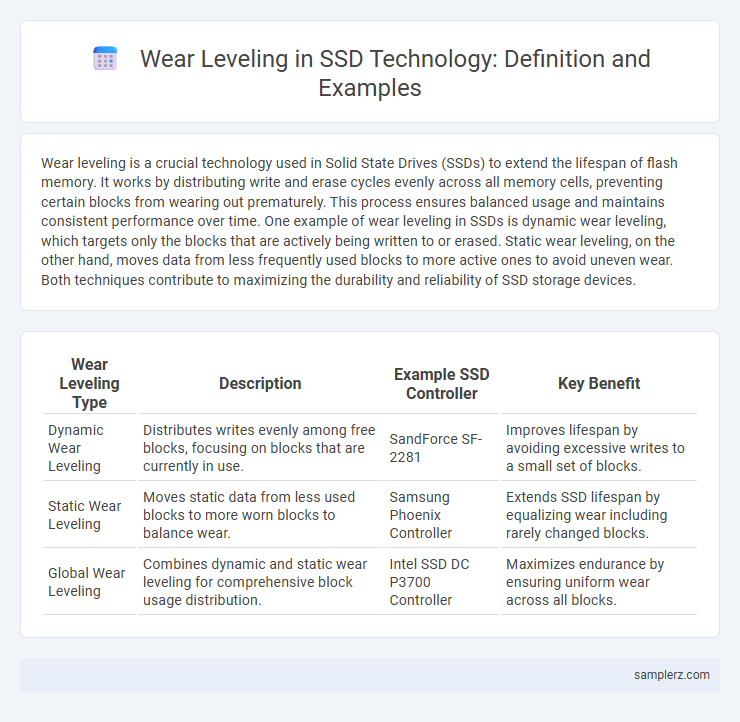Wear leveling is a crucial technology used in Solid State Drives (SSDs) to extend the lifespan of flash memory. It works by distributing write and erase cycles evenly across all memory cells, preventing certain blocks from wearing out prematurely. This process ensures balanced usage and maintains consistent performance over time. One example of wear leveling in SSDs is dynamic wear leveling, which targets only the blocks that are actively being written to or erased. Static wear leveling, on the other hand, moves data from less frequently used blocks to more active ones to avoid uneven wear. Both techniques contribute to maximizing the durability and reliability of SSD storage devices.
Table of Comparison
| Wear Leveling Type | Description | Example SSD Controller | Key Benefit |
|---|---|---|---|
| Dynamic Wear Leveling | Distributes writes evenly among free blocks, focusing on blocks that are currently in use. | SandForce SF-2281 | Improves lifespan by avoiding excessive writes to a small set of blocks. |
| Static Wear Leveling | Moves static data from less used blocks to more worn blocks to balance wear. | Samsung Phoenix Controller | Extends SSD lifespan by equalizing wear including rarely changed blocks. |
| Global Wear Leveling | Combines dynamic and static wear leveling for comprehensive block usage distribution. | Intel SSD DC P3700 Controller | Maximizes endurance by ensuring uniform wear across all blocks. |
Introduction to Wear Leveling in SSDs
Wear leveling in SSDs distributes write and erase cycles evenly across memory cells to extend the lifespan of the drive. This technique prevents premature wear of specific blocks by ensuring that data is not repeatedly written to the same physical location. Modern SSD controllers implement dynamic and static wear leveling algorithms to optimize performance and durability.
Importance of Wear Leveling for SSD Longevity
Wear leveling in SSDs evenly distributes write and erase cycles across memory cells, preventing premature wear of individual blocks and enhancing overall drive reliability. This process is crucial for maintaining SSD performance, as repeated writes to the same cells can lead to early failure and data loss. Effective wear leveling algorithms extend the lifespan of NAND flash memory, ensuring consistent operation and reducing the frequency of drive replacements.
Overview of Static and Dynamic Wear Leveling
Static wear leveling in SSDs redistributes data from rarely written blocks to evenly spread write cycles across the NAND flash memory, extending device lifespan by preventing premature wear. Dynamic wear leveling targets blocks currently being written to, balancing wear during active data changes. Combining both methods optimizes durability and performance by managing both static and frequently updated data efficiently.
Example: Dynamic Wear Leveling in Consumer SSDs
Dynamic wear leveling in consumer SSDs distributes write and erase cycles evenly across the NAND flash memory blocks to extend the lifespan of the drive. Unlike static wear leveling, it actively tracks frequently written blocks and relocates data to less used areas, reducing premature block failures. This technique is commonly implemented in SSD firmware by manufacturers like Samsung and Crucial to optimize performance and durability.
Example: Static Wear Leveling in Enterprise SSDs
Static wear leveling in enterprise SSDs prolongs device lifespan by redistributing data from less frequently written areas to evenly spread write cycles across all memory cells. This technique moves static data blocks, such as firmware or system logs, to new cells while reallocating frequently updated data to balance wear. Companies like Samsung and Intel implement static wear leveling algorithms to enhance reliability and performance in high-end data centers.
Wear Leveling Algorithms Used in Modern SSDs
Wear leveling algorithms in modern SSDs, such as dynamic wear leveling and static wear leveling, distribute write and erase cycles evenly across all flash memory blocks to prolong device lifespan. These algorithms track block usage through metadata tables and prioritize writing to less-worn blocks, minimizing premature wear of frequently accessed areas. Advanced SSD controllers incorporate adaptive wear leveling techniques combining erase count and data retention metrics to optimize durability and performance.
Case Study: Wear Leveling in Samsung SSDs
Samsung SSDs implement dynamic wear leveling to evenly distribute write and erase cycles across NAND flash memory cells, significantly extending the drive's lifespan. Their advanced firmware algorithms monitor block usage patterns and redirect data writes from heavily used blocks to less worn ones, minimizing cell degradation. This approach enhances reliability and maintains consistent performance in high-demand environments.
Real-World Scenarios of Wear Leveling Impact
Wear leveling in SSDs significantly extends device lifespan by evenly distributing write and erase cycles across memory cells, preventing premature failure in high-usage environments such as data centers and gaming rigs. In cloud storage services, wear leveling ensures consistent performance and reliability despite constant data rewriting. Enterprise servers benefit from this technology by maintaining optimal operation and reducing costly downtime caused by memory degradation.
Comparing Wear Leveling Efficiency Across SSD Brands
Wear leveling in SSDs extends device lifespan by distributing write and erase cycles evenly across memory cells, reducing premature wear. Comparing wear leveling efficiency across SSD brands reveals significant differences, with some models from Samsung and Western Digital employing advanced algorithms that enhance endurance by up to 30% compared to standard implementations. Higher efficiency wear leveling results in improved reliability and sustained performance in intensive data environments.
How Wear Leveling Reduces SSD Failure Rates
Wear leveling in SSDs distributes write and erase cycles evenly across memory cells, preventing premature wear on specific blocks and prolonging the drive's lifespan. By balancing usage patterns, wear leveling reduces the risk of cell degradation and data loss, enhancing overall drive reliability. This process is essential for maintaining consistent performance and minimizing SSD failure rates over time.

example of wear leveling in SSD Infographic
 samplerz.com
samplerz.com